
BATTERY
All lead-acid storage batteries discharge when not in use. Refer to
specific instructions and warnings that accompany the battery. If
such information is not available, observe the following precau-
tions when handling a battery:
• DO NOT use jumper cables and a booster battery to crank or
start the generator engine.
• DO NOT recharge a weak battery while it is installed in the gen-
erator. Remove battery from generator and recharge in a well-
ventilated area, away from fuel vapors, sparks, heat or flames.
• Battery electrolyte fluid is an extremely caustic sulfuric solution
that can cause severe burns. DO NOT permit fluid to contact
eyes, skin, clothing, painted surfaces, wiring insulation, etc.
If any battery fluid is spilled, flush the affected area with clear
water immediately.
• Always wear safety glasses, rubber apron and gloves when
handling a battery.
• Batteries give off explosive hydrogen gas while charging. The
gas can form an explosive mixture around the battery for sev-
eral hours after charging. Any spark, heat or flames can ignite
the gas and cause an explosion which can shatter the battery,
causing blindness or other serious injury.
BATTERY MAINTENANCE
The battery should be inspected per the “Service Schedule” sec-
tion. The following procedure should be followed for inspection:
1. Inspect the battery posts and cables for tightness and corro-
sion. Tighten and clean as necessary.
2. Check the battery fluid level of unsealed batteries and, if nec-
essary, fill with DISTILLED WATER ONLY. DO NOT USE TAP
WATER IN BATTERIES.
3. Have the state of charge and condition checked. This should
be done with an automotive-type battery hydrometer.
Storage batteries give off explosive hydrogen
gas. This gas can form an explosive mixture
around the battery for several hours after charg-
ing. The slightest spark can ignite the gas and
cause an explosion. Such an explosion can
shatter the battery and cause blindness or other
injury. Any area that houses a storage battery
must be properly ventilated. Do not allow smok-
ing, open flame, sparks or any spark producing
tools or equipment near the battery.
Battery electrolyte fluid is an extremely caus-
tic sulfuric acid solution that can cause severe
burns. Do not permit fluid to contact eyes, skin,
clothing, painted surfaces, etc. Wear protective
goggles, protective clothing and gloves when
handling a battery. If the fluid is spilled, flush
the affected area immediately with clear water.
Do not use any jumper cables or booster battery
to crank and start the generator engine. If the
battery has completely discharged, remove it
from the generator for recharging.
Be sure the AUTO/OFF/MANUAL switch is set to
the OFF position before connecting the battery
cables. If the switch is set to AUTO or MANUAL,
the generator can crank and start as soon as
the battery cables are connected.
Be sure the 120VAC power supply to the battery
is turned OFF, or sparking may occur at the bat-
tery posts as the cables are attached and cause
an explosion.
BATTERY REPLACEMENT
When replacing batteries, use the same number and type of battery
that was supplied with the unit, and is listed in the parts list in the
back of this manual.
NOTE:
The BCI number should be located directly on the battery.
REPAIR PARTS
The latter portion of this manual consists of exploded views,
parts lists and electrical data pertaining to this generator set. The
parts lists consist of (a) an item number, (b) a part number, (c)
the quantity required, and (d) a description of the part. The item
number corresponds to an identical number on the exploded view
drawing.
Stationary Emergency Generator
Maintenance
10-4
Maint013 Rev. D 04/09

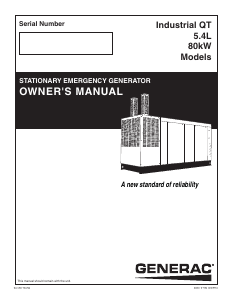


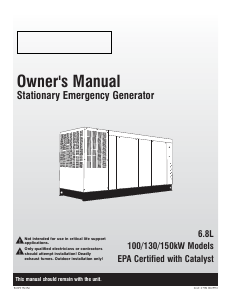
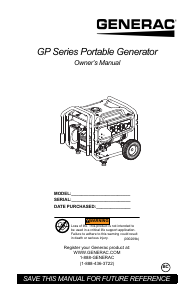
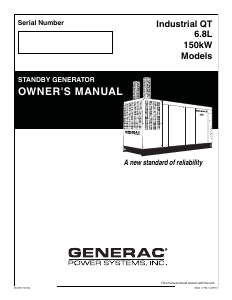
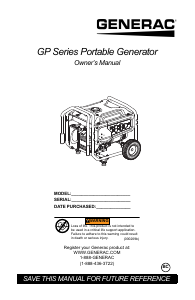
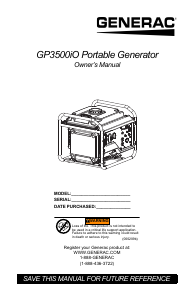
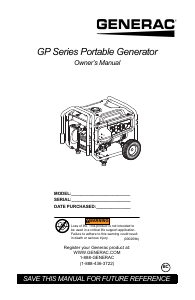
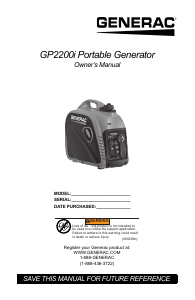

Join the conversation about this product
Here you can share what you think about the Generac QT08054KNANA Generator. If you have a question, first carefully read the manual. Requesting a manual can be done by using our contact form.